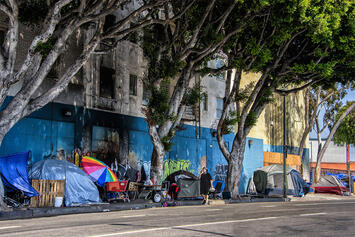
A journey through Los Angeles, the adopted home of Vice President Kamala Harris, offers a masterclass in urban dysfunction. As you drive through the streets of the southside, and along Central Avenue, the historic main street of black LA, now mostly Hispanic, the ambience is increasingly reminiscent of Mexico City or Mumbai: broken pavements; battered buildings; outdoor swap meets; food stalls serving customers much as one would see in the developing world.
Democrats, particularly in deep blue California and even bluer cities like Los Angeles, can clearly win elections. But what they can’t do is govern effectively. Virtually every Democratic city in the land is now in decline. Crime, especially of the violent variety, is rising. That’s shadowed by continued out-migration to less dense, more conservative areas, a trend that’s seeing the country’s biggest cities lose out economically.
But if signs of progressive failure are clear from New York to San Francisco, it’s Los Angeles where I feel it most keenly. I’ve lived here since 1975. Back then, the idea that this diamond in the sands could tarnish was unimaginable. But it has. Once a middle-class haven with a broad industrial base, LA now suffers the highest poverty rates in the state, and among the worst in the country. Dovetailed by failing schools and parks, and an exodus of residents and businesses, long-term prospects of this great American city look bleak — a future that could yet be translated right across the country.
Beyond making life miserable for residents and visitors alike, the chaos on the southside has clear demographic consequences. When I arrived, almost 50 years ago, LA was the undisputed king of urban growth in America. From a population of barely 100,000 in 1900, the city grew to nearly four million. Now, though, the trend has reversed. Today, the city and county of Los Angeles, together home to 10 million people, has fewer residents than in 2010. Even worse, the state department of finance now projects that the county’s population will drop by over one million by 2060.
This is not an exodus, as some assert, of the poor, nor of blubbering Trumpistas. Rather, many emigres now come from the city’s once-vibrant, multi-racial middle class. According to an analysis of IRS data, many are middle-income families in their childbearing years. LA is also losing the minorities and foreign-born residents who for decades sustained the city’s economic and demographic vitality. These days, African-Americans and Latinos instead flock to places like Houston or Miami in search of opportunity. “We are becoming more dystopian,” says John Heath, a lawyer and south LA native. “We can’t house people affordably and only build luxury, and there’s no place for a middle class.”
There’s a vicious circle here. As ambitious Angelinos leave, so too do the jobs that might have induced them to stay. That’s clear enough in entertainment, the city’s signature industry and a key funder of progressive politicians such as Harris. Consider Disney’s fabled Pixar studio, with production moving to other states or overseas. The once-promising space industry is in danger of being kneecapped too: just look at the departure of SpaceX.
Read the rest of this piece at UnHerd.
Joel Kotkin is the author of The Coming of Neo-Feudalism: A Warning to the Global Middle Class. He is the Roger Hobbs Presidential Fellow in Urban Futures at Chapman University and and directs the Center for Demographics and Policy there. He is Senior Research Fellow at the Civitas Institute at the University of Texas in Austin. Learn more at joelkotkin.com and follow him on Twitter @joelkotkin.
Photo: Russ Loar via Flickr under CC 2.0 License.












